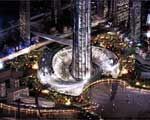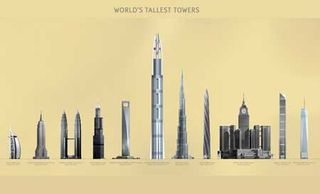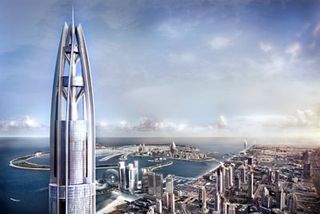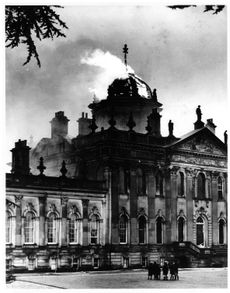Headline-grabbing Dubai
The desert city of Dubai is undeterred by world economic gloom in its quest to shatter the senses and deliver maximum wow factor to its visitors, finds Arabella Youens


Dubai defies most of the superlatives in use in the English language. A lightning quick visit will easily ascertain that it is at once audacious and arrogant, dazzling and gaudy. Just a generation ago it was a pearling port; today Dubai is busy recreating the best of the world’s most iconic cities such as New York, London and – certainly in kitsch value – Las Vegas, on its ever expanding shorelines. And it's doing all this with seemingly scant regard to either of the two major concerns currently dominating world headlines: chronic financial instability and the effects of global warming.
Of course, it’s not the only city to have been whipped out of a desert dust bowl with much success. And this success is all the more impressive considering Islamic laws mean they didn’t even have the lure of slot machines and Baccarat to use as bait. Dubai has attitude and imagination in spades and what they don’t have, they will build and once built, people will come.
But like a child whose growth spurt has arrived suddenly and unexpectedly, Dubai is suffering from growing pains. In 1990, just 600,000 tourists visited but by 2006, that figure had swollen to 6.5m. Its annual population growth is a stomping 6%-7% and something like 900 new residents arrive every day. The city is one enormous construction site. Cranes litter the skyline made up largely of half-built apartment blocks. At ground level, 8-lane highways are choked with traffic as no one seems to have given much thought to the concept of getting from A to B without leaping into a car. A metro is on its way but the construction priorities appear heavily weighted towards more revenue-driving tourist and residential projects.
What they have caught on to, and seem unlikely to let go of, is the fact that people will pay a lot of money to live by the sea, even if the temperature of the sea during the 5-month long summers is a long way from refreshing. Regardless, a simple mathematical equation was enough to prove that the seemingly paltry 70km of coastline was inadequate for the grand plans of Dubai and the rulers showed no qualms in redrawing the map of the emirate by plundering the sand burrows in the Arabian Gulf and with the help of the Dutch engineering firm, van Oord.
Trumping any previous efforts by the Far Eastern cities of Singapore and Hong Kong, Dubai must today – although no one would admit to this – be responsible for reclaiming the largest amount of land from the sea throughout the world. It certainly streaks ahead in terms of bizarre designs. In what appears to be the exclusive right of one Government-backed local developer, Nakheel (meaning Palm in Arabic), the projects are awe inspiring examples of what vast sums of money and clever engineering can achieve. Look down when you’re next flying over the Gulf at 33,000 feet and beneath you lie not one but three palm shaped islands, each one larger than the first; the 300 islands that roughly form the shape of the World; and, one day soon, the beginning of islands that make up The Universe.

The World's tallest towers (including those under construction)
But before anyone got bored of these reclamation plans, this month the same developer announced it was entering into the fray to build the world’s tallest building: Nakheel Tower. Feel like you've heard that before? The current occupent of this highly sought-after world record is just down the road at Burj Dubai. But their grasp on this post is slippery. Last week at the announcement Nakheel wouldn’t give the building's exact height to journalists, a shrewd move considering just a week later, a Saudi prince has announced that he is to build a tower of a similar height in Jeddah.
Sign up for the Country Life Newsletter
Exquisite houses, the beauty of Nature, and how to get the most from your life, straight to your inbox.
Back to what we do know about this ambitious plan. Nakheel Harbour & Tower will cost $38 billion and will take over 10 years to complete. Heavily stressed during the launch was the fact that the design includes Islamic elements inspired by the gardens of the Alhambra in Spain, the harbour of Alexandria in Egypt, the promenade of Tangier in Morocco, and the bridges of Isfahan in Iran. On examination, the influence is light but in the Middle East's most western-leaning city (where over 80% of residents are expats) it seems like perhaps a well-timed nod to reinforcing Dubai's Muslim foundations.

Nakheel Tower
The tower will soar over 1km into the sky with over 200 floors and, most likely, a penthouse apartment at the top. The building is so tall that it will experience five different microclimatic conditions over its height and the temperature at the top of the building may be as much as 10 degrees cooler than the bottom. ‘Nakheel is shaping Dubai and inspiring the world,’ announced CEO Chris O’Donnell at the launch of the project. ‘This is a groundbreaking engineering feat which has never been done before.’ Mr O'Donnell added the structure would be the centre-piece of an inner-city harbour ('the world's first') and would become the emirate's unofficial capital.
The team from Nakheel appear undeterred by the economic climate of the rest of the world during the launch of this new project. While outside commentators are anticipating a correction in residential real estate in Dubai of between 10% and 15% over the next 12 months, Manal Shaheen, director of sales, is bullish: ‘We are very confident about the market. We’ve achieved twice the number of sales this year to September than we did in 2007. Yes, the Middle East will be affected, but it will be minimal.' Mr O'Donnell is equally confident: 'We'll recover faster. We have strong fundamentals here and petrodollars are still coming in.'
-
 Interiors that inspire in a four-bedroom cottage in Hertfordshire
Interiors that inspire in a four-bedroom cottage in HertfordshireCome for the Grade II-listed family home an hour from Central London, stay for the interior-design inspiration.
By James Fisher Published
-
 The house that refused to die: Castle Howard's spectacular 21st-century renaissance
The house that refused to die: Castle Howard's spectacular 21st-century renaissance'Molten lead cascaded from the roof into the centre hall, and then the dome crashed to the ground, leaving the interior an inferno of blazing timber and shattered stonework.' 85 years on from the devastating fire at Castle Howard, restoration is still going on. Annunciata Elwes reports.
By Annunciata Elwes Published
